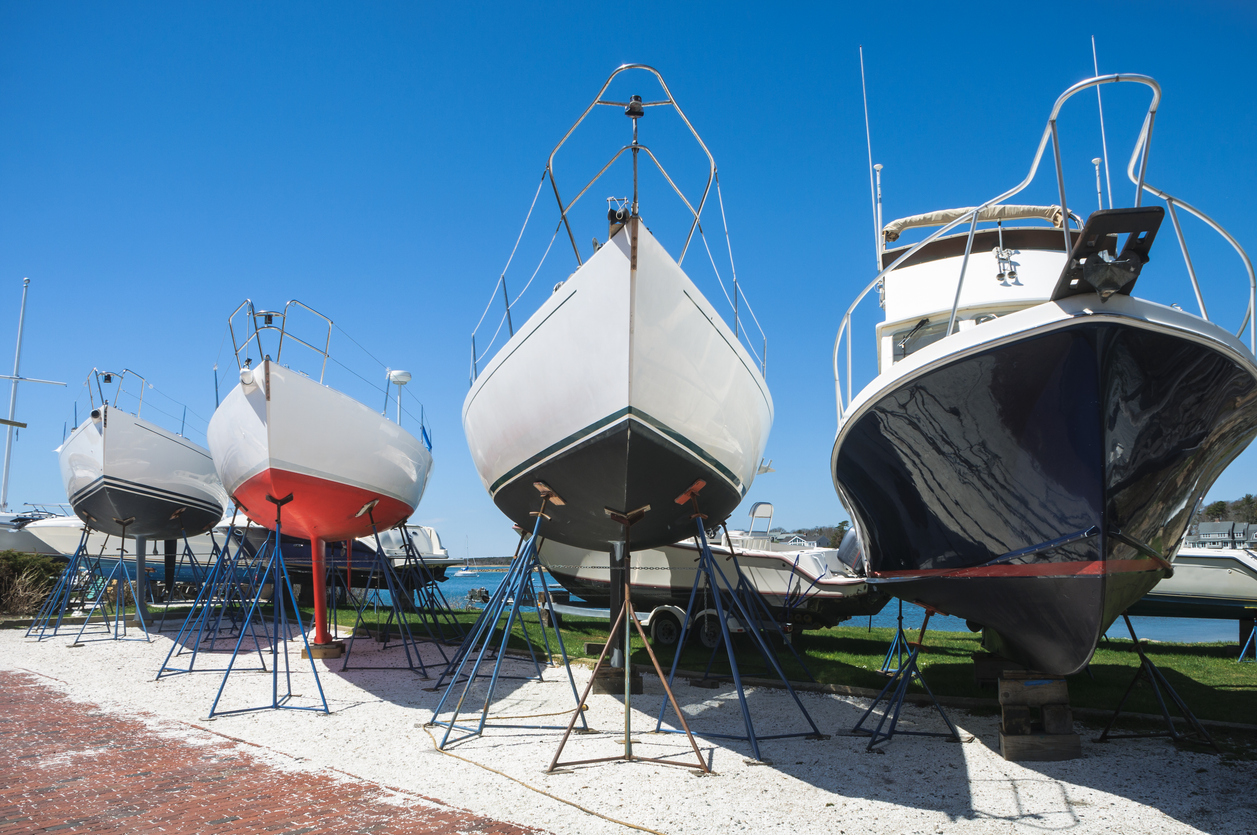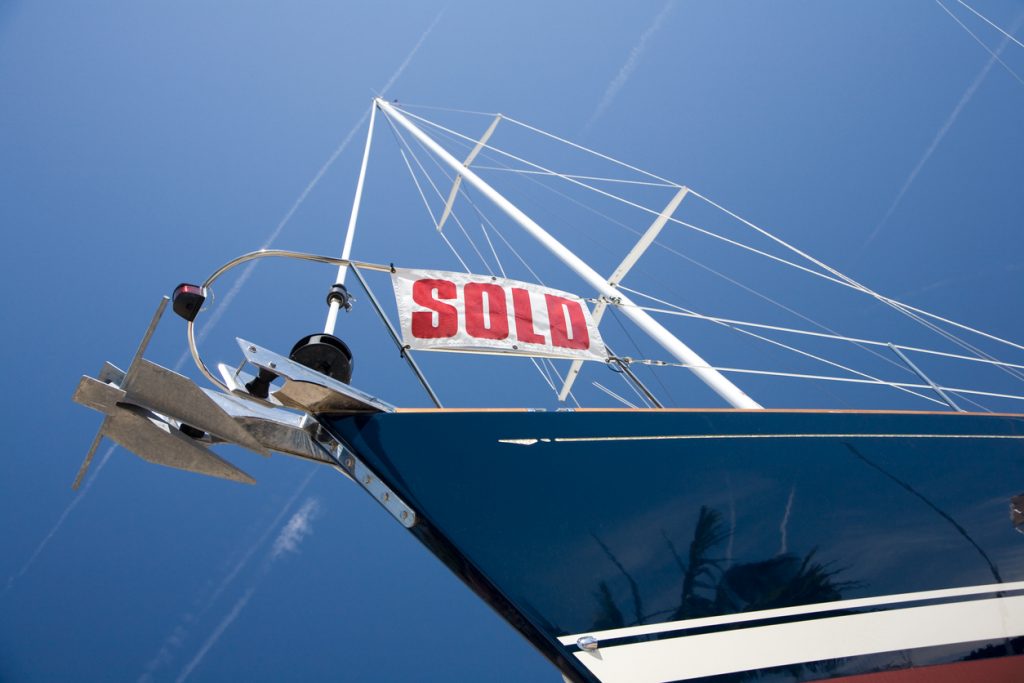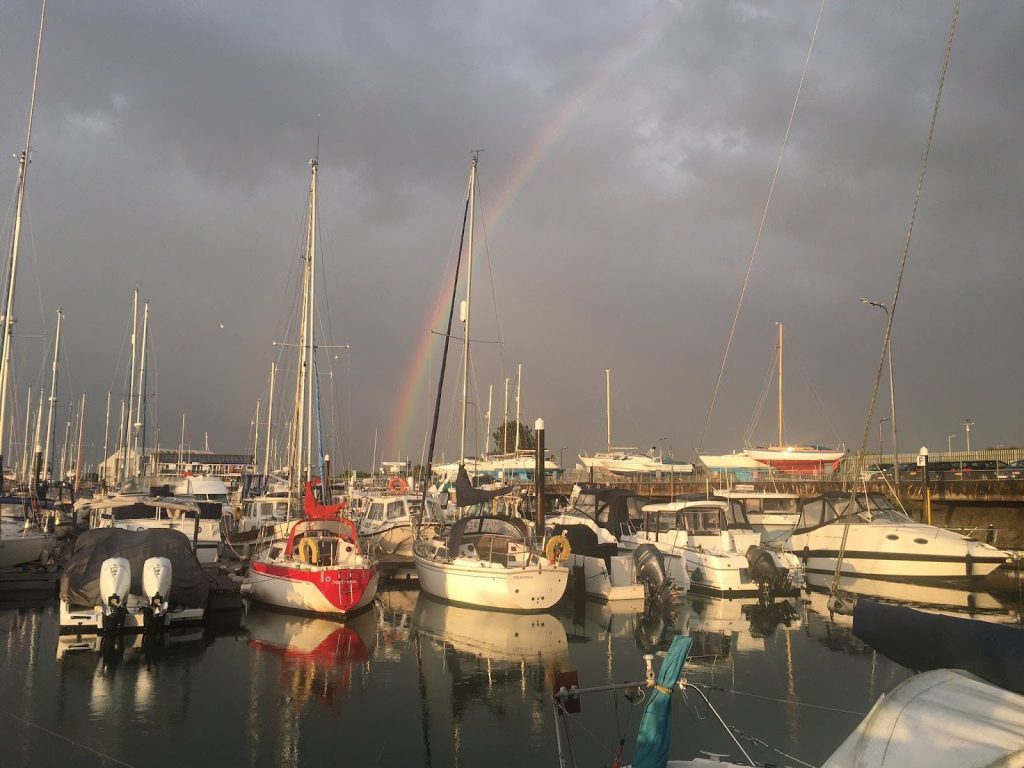Aground. Beached. Stuck fast. Call it what you will. Arwen balances precariously on some submerged boulders, her rudder wedged and skeg entangled by floating rafts of bladder-wrack. Oar pushing and vigorous rocking side to side have failed to dislodged her. In two feet of water I’m happy to jump out and lift her stern off the boulders but my way is blocked and it’s all terribly embarrassing. I’m trapped in my boat by a large, angry Canadian Goose. It’s ludicrous.
On this three-day voyage, to the hidden boatyards of Treluggan and Calstock, I aim to do as much as possible under sail and oar. An unconfident sailor, too quick to motor when winds drop or tides turn foul, I am often plagued by self-doubt, uncertain that my sailing skills will get me out of ‘trouble’. I can’t quite leave the outboard behind and my over-reliance on it hampers my skill development.
With rising early morning spring tides and south to north westerly breezes F2/3 (gusts to 16kts), blue skies and hot temperatures, conditions seem perfect. Pre-launch rigging at Queen Ann’s Battery (QAB) Marina is swift. Launch fees paid, a quick chat with boatyard staff to catch up on family and yard news. A final rigging and stowage check – waterproof bags secured by bungee straps under side decks, charts, compass and handheld GPS clipped to starboard centre thwart. Foulies and food to hand. [I always launch from QAB - free launch ramps are listed here}
08.20am Arwen eases out of the marina, I keep a wary eye out for reversing tour boats, water taxis and traffic exiting the lock gates in Sutton Pool. With no imminent traffic threats inside the Cattedown, sails are immediately raised, the outboard killed and course set for clearing Mountbatten Breakwater and my customary shakedown circumnavigation of Plymouth Sound. A pleasing start, for normally I motor into Jennycliff Bay to raise sails. Less to hit out there!
10.43am Anxious whenever I sail up to a mooring buoy, today it just has to be done. “No outboard, except for Sutton Pool” says my inner voice. Calculating tide, winds and point of sail successfully, I hook onto the yellow buoy, north of Drakes Island, and with rudder and centreboard raised, furl the mainsail. Phew! It doesn’t normally go this well. Learning to dinghy sail in the Med doesn’t prepare you for the vagaries of strong English tides. Stressful, but at least there was no mortifying mad, arm stretching lunge with mooring pole. Ah, the blessings of a furling jib and all control lines leading to the aft cockpit area!
A quick cuppa and a cheese and marmite sarnie. Arwen always sails with a near inexhaustible supply of these! Marmite haters are rarely invited onboard unless they bring home baked cake with them as an apology. My yellow waterproof notebook says ‘depart DI mooring 11.10am – last of slack’. So, there is time for odd jobs. I adjust a GoPro camera mount, swap around one or two bags to improve hull trim and update my log. I ping an ‘I’M OK’ message on my SPOT PLB to my wife and try to memorize pilotage notes for the first leg up the Hamoaze. 273M, 0.5NM to West Vanguard starboard channel buoy.
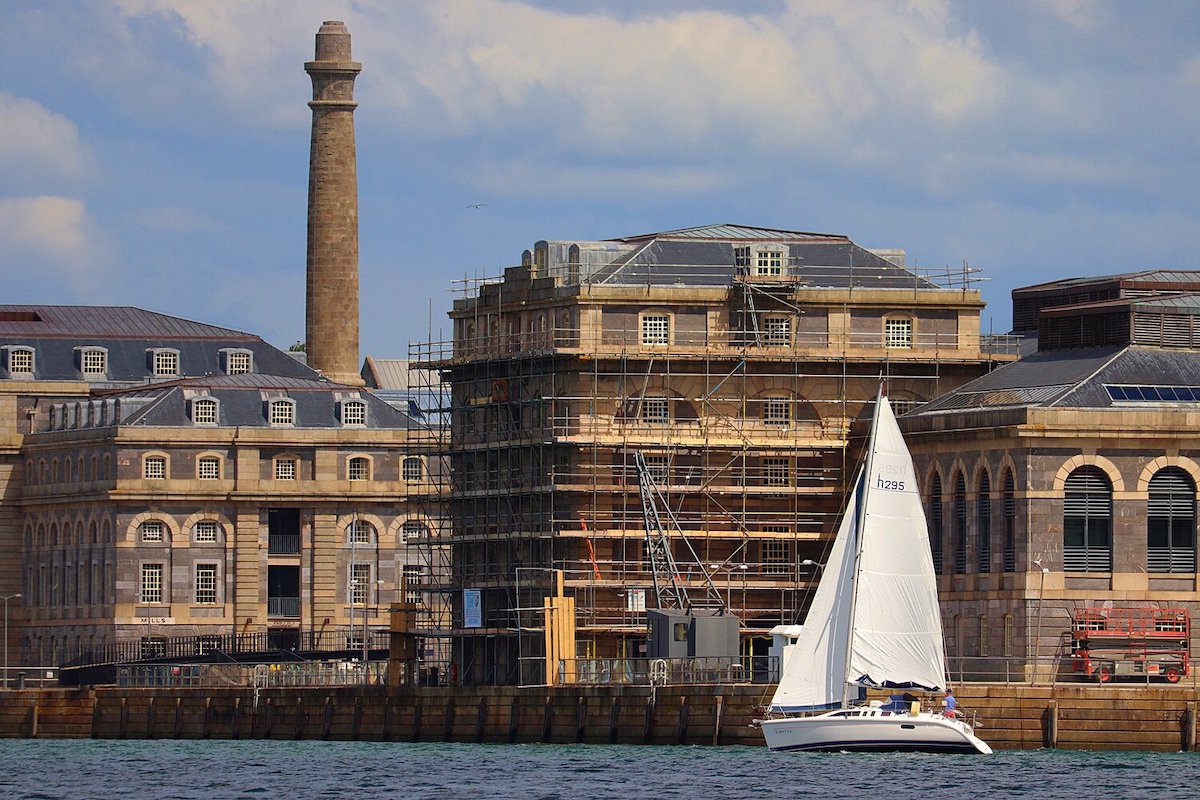
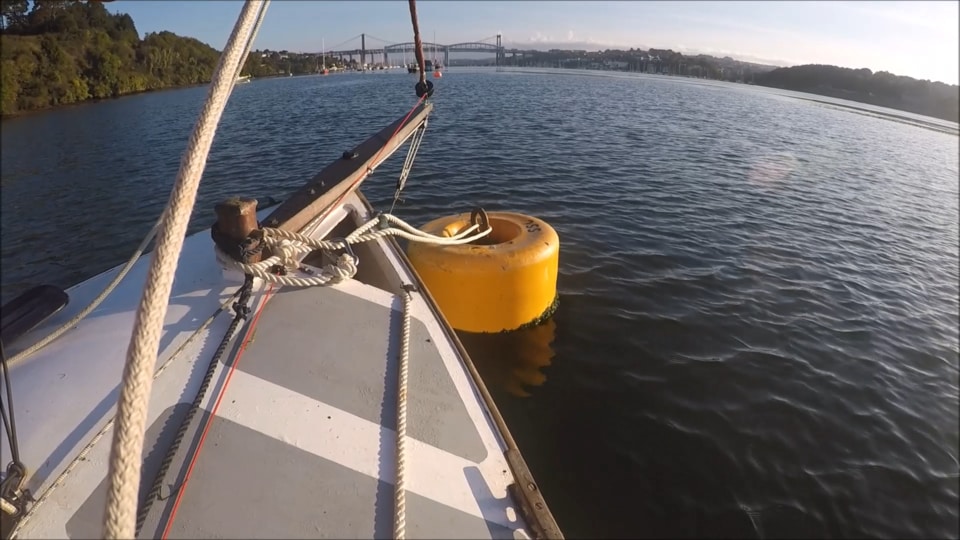 Off Sand-Acre starboard channel buoy whilst watching the navy ribs practising MOB drills ahead, I get a visit from an instructor. “Could you keep well clear, north of HMS Brecon Sir?” “It’s only today sir, they will have grasped it by tomorrow.” I note the emphasis on ‘will’ and grin. “We’ve had worse Sir, though to be fair I’m struggling to remember when”. “Take care Sir, lovely boat, where you be going? Treluggan? Ah! Proper boatyard that is” and he is away to praise one successful crew and scold another for allowing their fender to drift into small craft moorings. I try not to laugh loudly as with a large splash one standing trainee pointing to a drifting MOB fender, is sent overboard by an over-enthusiastic helmsman who executed a rather speedy turn to starboard. Pithy sarcastic ripostes accompany the splash, but weary, resigned looks on Petty officers’ faces say it all. A retired teacher, I feel their pain.
Abeam Forder Lake. “Don’t go in Steve, what if you run out of water Steve?” That self-doubting inner voice again! Another time then, but I drift a moment to admire the views. From early medieval times to the mid-20th Century, flour milling, fulling, market gardening, lime burning and roadstone quarrying have left indelible marks on this pretty conservation area. 19th Century barges brought dockyard horse dung and street sweepings to the quayside, natural fertiliser for local farmers to carry away in carts. Market garden produce went back down river to the city. SW DCA members have had one or two overnight rallies and annual winter planning meets here.
Off Sand-Acre starboard channel buoy whilst watching the navy ribs practising MOB drills ahead, I get a visit from an instructor. “Could you keep well clear, north of HMS Brecon Sir?” “It’s only today sir, they will have grasped it by tomorrow.” I note the emphasis on ‘will’ and grin. “We’ve had worse Sir, though to be fair I’m struggling to remember when”. “Take care Sir, lovely boat, where you be going? Treluggan? Ah! Proper boatyard that is” and he is away to praise one successful crew and scold another for allowing their fender to drift into small craft moorings. I try not to laugh loudly as with a large splash one standing trainee pointing to a drifting MOB fender, is sent overboard by an over-enthusiastic helmsman who executed a rather speedy turn to starboard. Pithy sarcastic ripostes accompany the splash, but weary, resigned looks on Petty officers’ faces say it all. A retired teacher, I feel their pain.
Abeam Forder Lake. “Don’t go in Steve, what if you run out of water Steve?” That self-doubting inner voice again! Another time then, but I drift a moment to admire the views. From early medieval times to the mid-20th Century, flour milling, fulling, market gardening, lime burning and roadstone quarrying have left indelible marks on this pretty conservation area. 19th Century barges brought dockyard horse dung and street sweepings to the quayside, natural fertiliser for local farmers to carry away in carts. Market garden produce went back down river to the city. SW DCA members have had one or two overnight rallies and annual winter planning meets here.
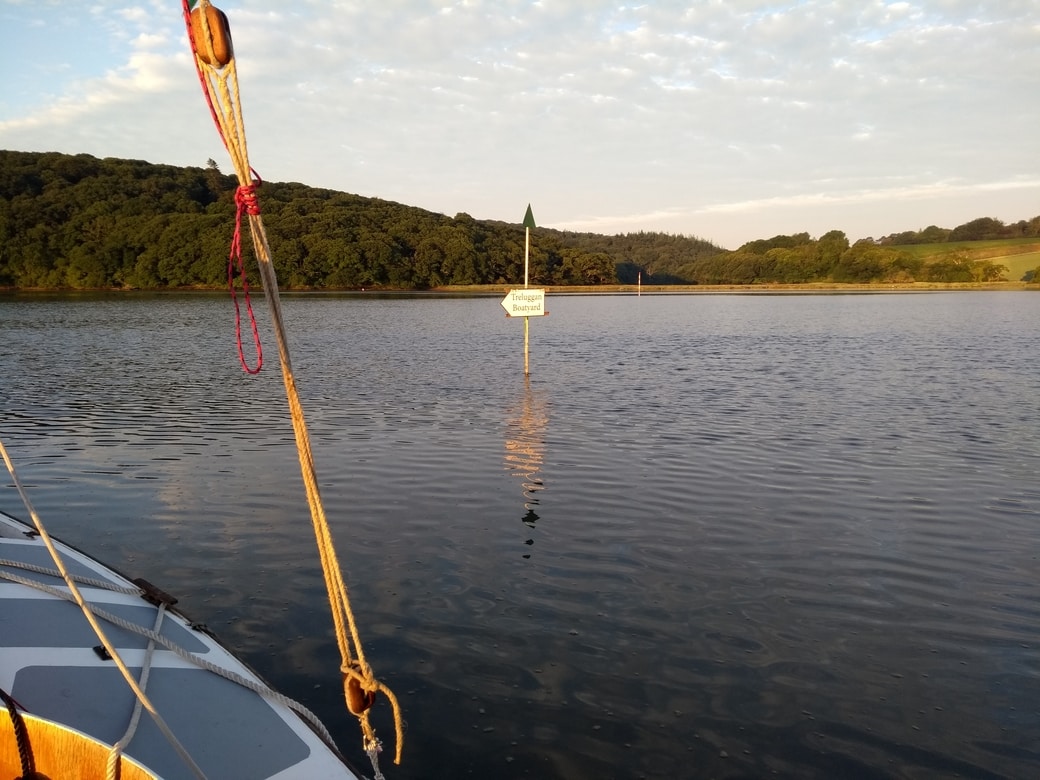 The 'changing position' sign post
Today, the pole is swivelled the right way but I still chuckle whilst fumbling for my yellow notebook and its colour map of channel and waypoints, printed off the Treluggan Boatyard website. New waters for me, it’s helpful to line map up with the channel ahead but I still unship the long-handled paddle from the foredeck and lie it ready on the port thwart, “just in case!”
With jib furled and main sail eased out to the starboard shroud, we glide past the first starboard marker pole. The boomkin rattles in its retaining block as the mizzen suddenly switches side and I check it hasn’t snagged on the up-tilted outboard engine. With centreboard up fully, we are practically on a downward run and lulled by hot sun, blue skies and a languorous drift upriver, I reach for the binoculars and scan the Erth Island marshes. The lens compressed view brings the low Devonian slate and grit hills, sessile oak woodlands and muddy reed fringed creeks closer. A geographical oddity of intertidal mudflats and salt marshes full of motionless white egrets, wildfowl and wading birds; found in an upper ria valley river system, the marsh is out of place. A fascinating oddity.
16.15pm Crunch. I fall forward. The grating hull suggests all is not well. No warning thump of centreboard against ground obviously. Allured by the stunning scenery I lost attention and drifted shoreward. The rudder is jammed, the release cleat on the tiller failing in its primary function! “You idiot! Rule 1 – focus on the course ahead!!”
Trapped in my boat by a very disgruntled goose! Serves me right!
The 'changing position' sign post
Today, the pole is swivelled the right way but I still chuckle whilst fumbling for my yellow notebook and its colour map of channel and waypoints, printed off the Treluggan Boatyard website. New waters for me, it’s helpful to line map up with the channel ahead but I still unship the long-handled paddle from the foredeck and lie it ready on the port thwart, “just in case!”
With jib furled and main sail eased out to the starboard shroud, we glide past the first starboard marker pole. The boomkin rattles in its retaining block as the mizzen suddenly switches side and I check it hasn’t snagged on the up-tilted outboard engine. With centreboard up fully, we are practically on a downward run and lulled by hot sun, blue skies and a languorous drift upriver, I reach for the binoculars and scan the Erth Island marshes. The lens compressed view brings the low Devonian slate and grit hills, sessile oak woodlands and muddy reed fringed creeks closer. A geographical oddity of intertidal mudflats and salt marshes full of motionless white egrets, wildfowl and wading birds; found in an upper ria valley river system, the marsh is out of place. A fascinating oddity.
16.15pm Crunch. I fall forward. The grating hull suggests all is not well. No warning thump of centreboard against ground obviously. Allured by the stunning scenery I lost attention and drifted shoreward. The rudder is jammed, the release cleat on the tiller failing in its primary function! “You idiot! Rule 1 – focus on the course ahead!!”
Trapped in my boat by a very disgruntled goose! Serves me right!
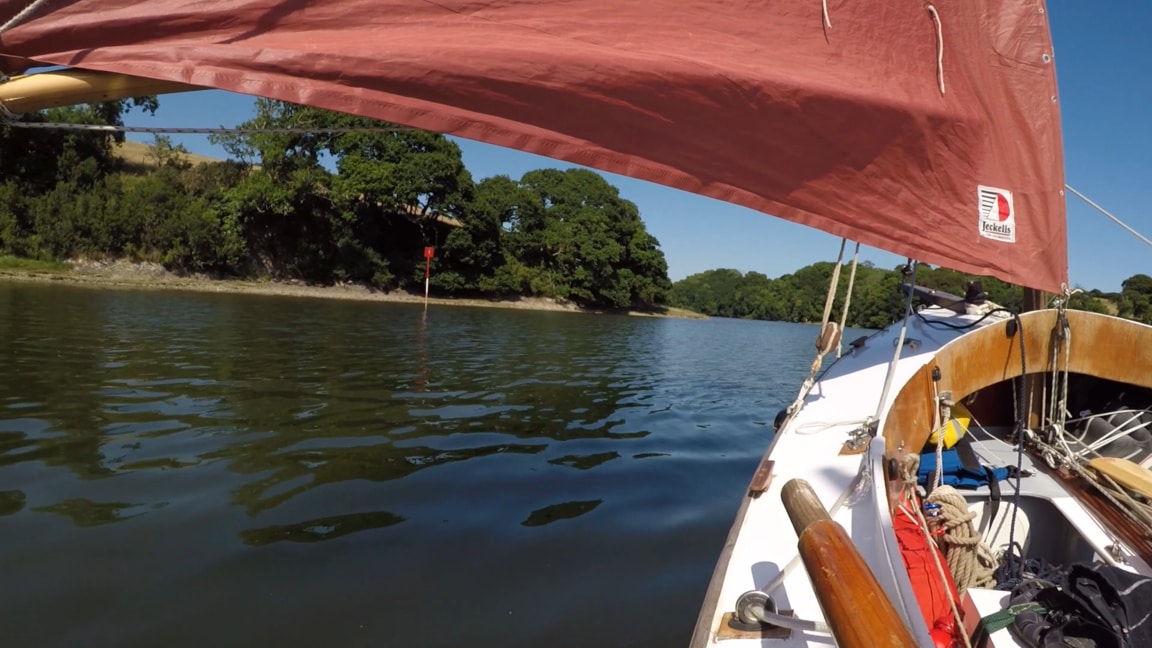
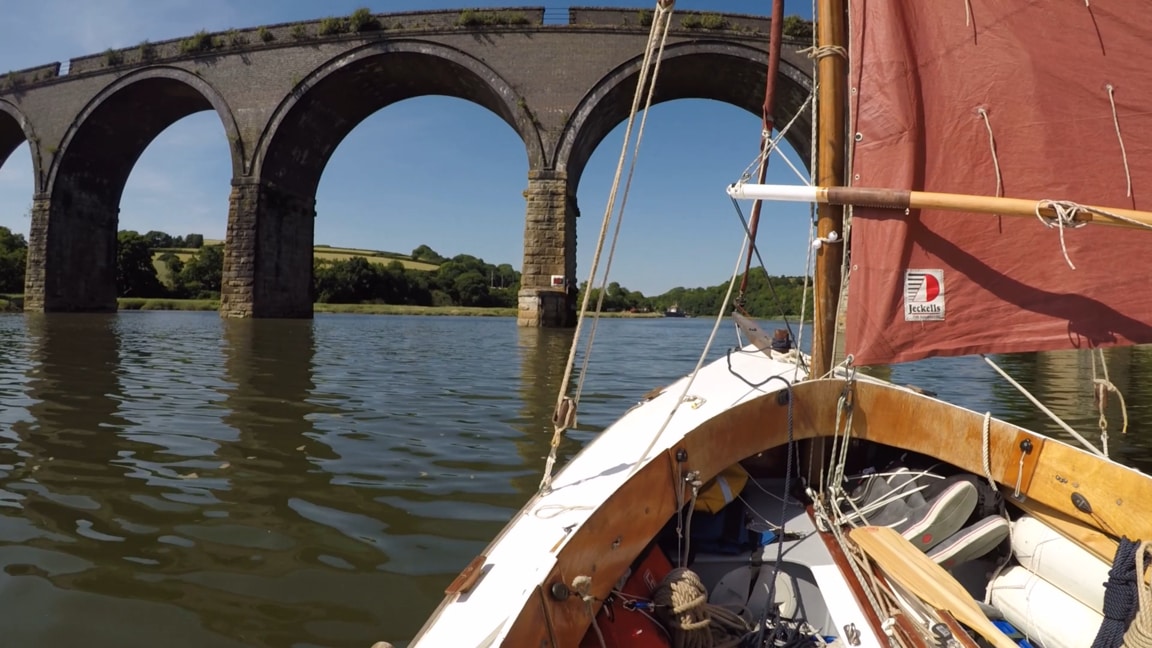
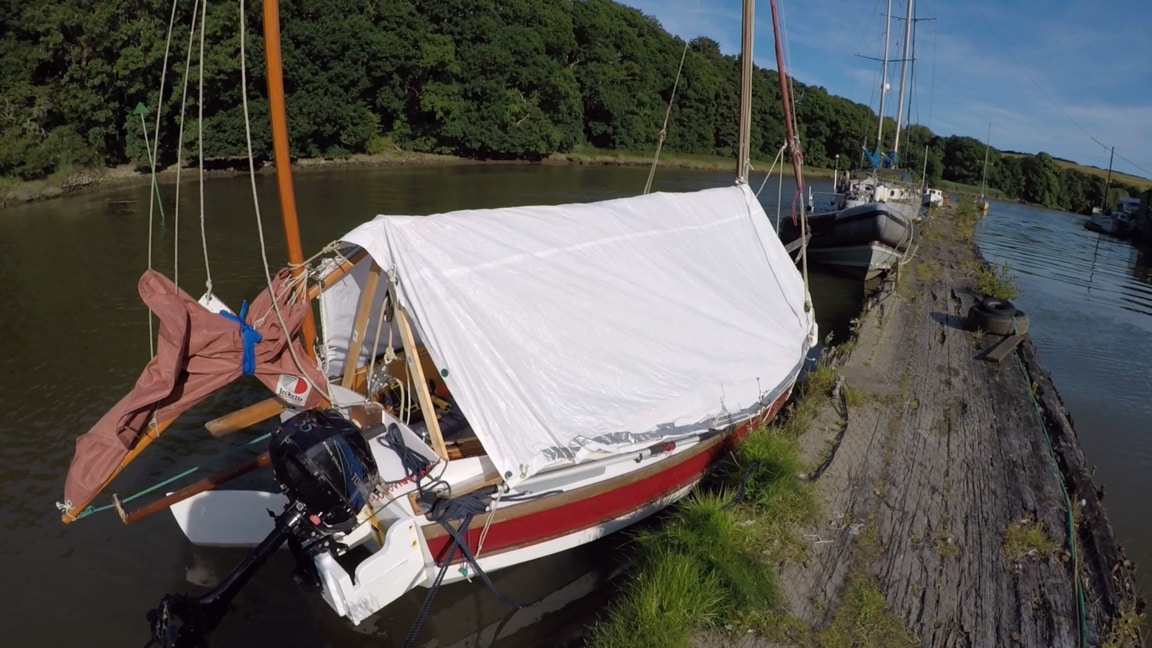
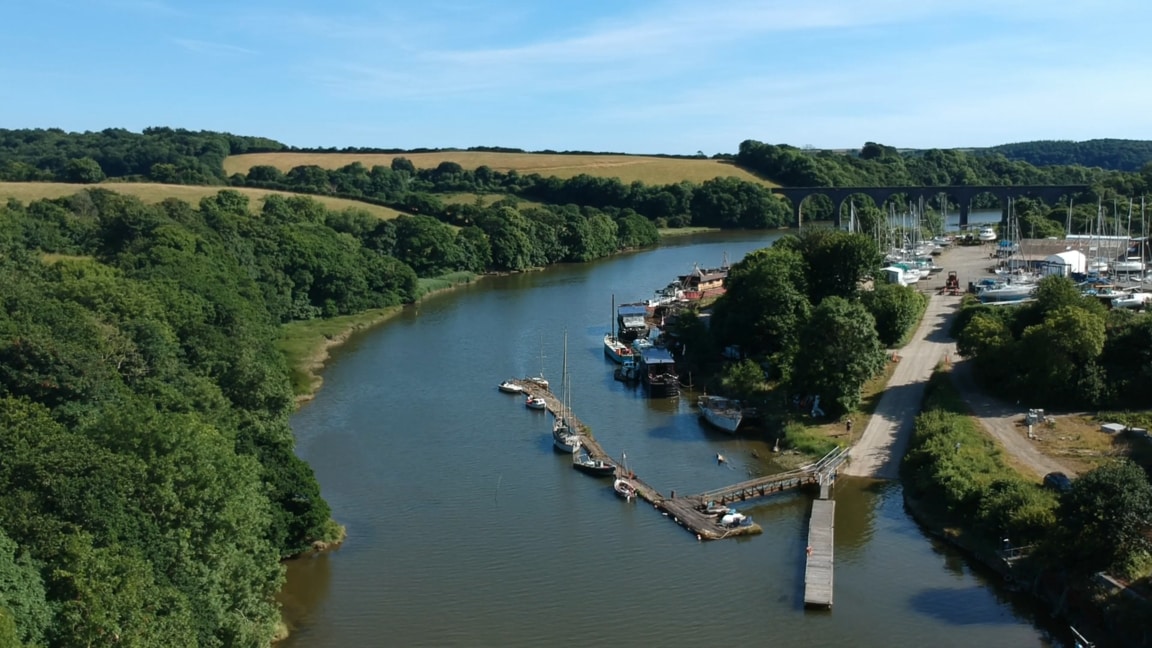
11.15am A final perusal of the cockpit and rigging. Sails raised, painter is released, boards hauled down. We drift back off the buoy slightly and I unfurl and back the jib to swing Arwen’s bow around more quickly. We successfully clear the buoy without incident and without the outboard. Now here’s another first!
Never following pilotage notes slavishly, I reach across the Tamar entrance towards Barn Pool rather than the buoy. A sheltered anchorage from prevailing westerlies, it offers a café, pub, formal gardens and coastal walks in the Mt.Edgecumbe estate. I often anchor towards the northern end of the stone/shingle beach where there are less rocks, using a long shoreline from the stern and my bungee anchor buddy on a bow anchor to pull Arwen back off the beach to deeper water.
On a more northerly course towards Stonehouse pool, the flogging mainsail suggests I closed too close with the western shore. I’m struggling to find the wind. A quick flick of the tiller and we move away from the forbidding rocks beneath the Cremyll gun battery to a more central channel position, the red ‘Battery’ channel marker slipping rather too close for comfort down our port side. As we catch the 8kt SW breeze once more, I wonder whether the tourists admiring the views atop this former seven-gun battery, part of the 1860’s inner sea defences to protect the Dockyards ahead, know it was a former royalist blockhouse in the English civil war; or of its important role as a guardroom for the anti-submarine booms during WW2?

Passing the redeveloped Royal William Yard at the entrance to Stonehouse Creek
11.40am A fast reach towards Cremyll’s Mashford’s yard for a quick peak inside. Twigs, driftwood, plastic bottles, frayed blue three strand rope and bits of white polystyrene packaging float by. A saddening sight only cheered by the appearance of several drifting jellyfish; their pale, translucent canopies adorned with four brown circular markings shimmering in the sunlight. Making 4.2 kts, I guess that’s respectable. Mayflower Marina and the Royal William Yard fall rapidly astern. VHF CH14 chatter suggests no imminent big ship movements out of the dockyard ahead. That’s a relief. I idly wonder what Sir John Rennie the original architect of the Royal William Victualling Yard would make of its £60m regeneration – bakery, armoury and cooperage turned into luxury apartments, boutique shops, small businesses and restaurants? I’m almost tempted to call Mayflower Marina opposite for a coffee. Two hours free pontoon mooring, if you call in at the delightful ‘Lazy Jack’s’ café. No, time is pressing, onwards and upriver we go!
Only a dive boat on the Mashford’s slipway. There has been a boatyard at this site for 270 years, working on everything from Tamar barges and torpedo boats to fishing and tug boats. It was said that if a captain of a RN ship was presented with a west country crew that had shipwrights trained at this Cremyll yard then he went to sea a happy man!
Gusty winds rock Arwen as we leave the shelter of the Cremyll peninsula and draw alongside the extensive mudflats of Millbrook and St John’s Lakes. I ease the main and head over towards the West Mud channel buoy. No high-speed rib training by the Royal Navy today, nor porpoise shoaling mackerel into the exposed mudflat shallows. Next time, with more water in the various entry channels, I might visit one of the marina cafes to be found across the other side of these mudflats.
Arwen’s sails are trimmed and the Huntingford helm impeder set for a long broad reach up to the chain ferries that carry traffic between Torpoint and Devonport. A narrowing channel, I’m thankful I’m not beating up it in a northerly headwind. With extensive mooring trots on the western shore and the start of a long 100m exclusion zone in front of the naval dockyards, the MOD Police get very ‘strident’ with small craft that close within 100m of any moored frigates and submarines, as I have found to my cost in the past. Without being melodramatic, the police are heavily armed and rumour has it, sharpshooters are ‘ready’ onshore!
Tidying sail sheets and halyards into homemade halyard bags, the knot in my stomach grows as I plan my ferry approach. “Prepare the outboard, just in case”. “What if the breeze dies?” Self-doubt, I’m always plagued by self-doubt! Winds remain steady, coming across the port transom quarter. I maintain a mid-channel course.
Up past Torpoint Marina with its old ballast pond walls built by French prisoners of war in 1783 to shelter the ballast barges, one of only two surviving ponds in the UK. Two hundred metres astern, a stunning cream hulled, tan sailed yacht is closing fast. She’ll pass me just as I shoot the ferries. “I’ll be squeezed, no channel room”. Self- doubt! “Use the outboard Steve!”
100m to go and an irritating whistling sound pervades the cockpit. I’m nervously sucking air through my teeth. Phew! Release the impeder. Right, two ferries have landed and one is about to pass through the channel centre. I monitor the hand held GPS speed..4.2….4.6kts. Without the drag of the outboard, and with tidal assist I’m lengthening the gap between me and the boat behind. I pass astern of the central ferry with plenty of room either side.
No disasters, no losing wind, speed or steerage at a critical moment. My nightmare of passing so close to the ferry that I catch it’s chains on the centreboard, are unwarranted (I know I only have 2’6” draft with centreboard down – but it’s MY nightmare, OK?). Most sailors shoot these ferries automatically without thinking or suffering paranoiac thoughts. For me, this is another small triumph.
Minor helm adjustments, a Murray Mint to soothe frayed nerves and the flood tide and SW breeze carry us past Yonderberry jetty with its large semi-permanently moored fuel tanker. Two of its crew languish on a lighter moored alongside the hull, having an illicit smoke, undoubtedly oblivious to the irony of the scene; for above them, in four-foot-high red capital lettering on the Hull superstructure is the sign ‘NO SMOKING’. I check speed and course, best not hang about here too long.
The wooden boat catches up with us just abeam Weston Mill basin, where HMS Albion, the assault ship lies moored, protected by an ever-present MOD boat, holding its station at the basin entrance. ‘Inanda’, is a 25’, 80-year-old Debden four tonner, once described by Classic Boat as ‘one of the nicest small British cabin cruisers of the 1930’s’. Fellow blogger ‘Dirtywetdog’ is on the last leg of a long, difficult and exhausting voyage bringing her home from Ipswich to her new berth at the Calstock boatyard. After exchanging greetings, I search ahead for my favourite little mooring buoy off Henn Point, silently praying it will be vacant.
0.4nm to go. Off the starboard bow, the slipways of HMS Tamar are engulfed in a thick smoky fug as landing craft and hovercraft move about. The overwhelming noise drowns out the sounds of the dockyard downriver. 2500 employees supporting 400 local firms, the dockyard contributes 10% of the local economy and is still the main Vanguard Sub refitting base and home to seven type 23 frigates and the Antarctic Patrol ship HMS Protector. The Royal Navy is part of the fabric of our fair Ocean City and like most Plymothians, I’m rather proud of this naval heritage.
Passing the buoy to plan our approach, I do a quick gybe and a downriver close reach approach. Too fast, blown off, a mad scramble with mooring pole and a trip over the centre thwart resulting in a ripped halyard bag and bruised shins. A buoy arrival best described as ‘inelegant and flustered’. Another cuppa and restorative cheese and marmite sarnie sooth tattered nerves. This ‘no outboard malarkey’ is proving hard work. I fill in log book, ping another SPOT message and reach for the sail repair ditty bag. Halyard bag repaired, I search for those annoying bits of fine gravel that scratch Arwen’s bottom boat grey anti-slip paintwork and become fascinated by the foot stirring antics of a lanky legged heron as it stalks and harpoons small fry in the shallows.

Temporary mooring stop at Henn Point at the mouth of the river Lynher
13.40pm and the Lynher sandbanks and channel margin mudflats should be covering over. I aim to arrive at Treluggan just on the top of the 5.0m tide around 5.00pm-ish. Helpful pilotage notes printed off the Treluggan Boatyard website the night before recommend entering the final mile channel up to the yard around 1.5hrs before high tide. I draw only 2’ 6”or so with centreboard down but I’ll stick to their advice and not enter this final channel much before 3.30pm. I pour another cuppa and watch a train trundle over the Brunel Bridge upriver.
I snag the dangling mainsheet on the mooring eye and it sends Arwen into an ‘alarming’ sail around the buoy. Sailing back upriver between two barges and Carew point, I forget about the leeward wind shadow effect of trees and shore and lose the wind. An undignified departure, “I must get better at anticipating potential pilotage problems”. Still, better to be too close to a windward shore with room to leeward than on a lee shore with nowhere to go?
Had Arwen sailed between Lynher port can to Beggar Island port can (256M 0.4NM) in the late 1800’s, she’d have just past the last 5000 tonnes wooden three decker HMS Defiance. Built for the Navy in 1861, she never saw service, being instantly converted to a permanently moored new Torpedo and Mines training school off Wearde Quay. Defiance Halt on the GWR Penzance-Paddington railway line has long gone, as has Defiance, towed away in 1930, so ending 45 years of naval training at Wearde Quay. [Do a google search for old photographs – she was a splendid sight].
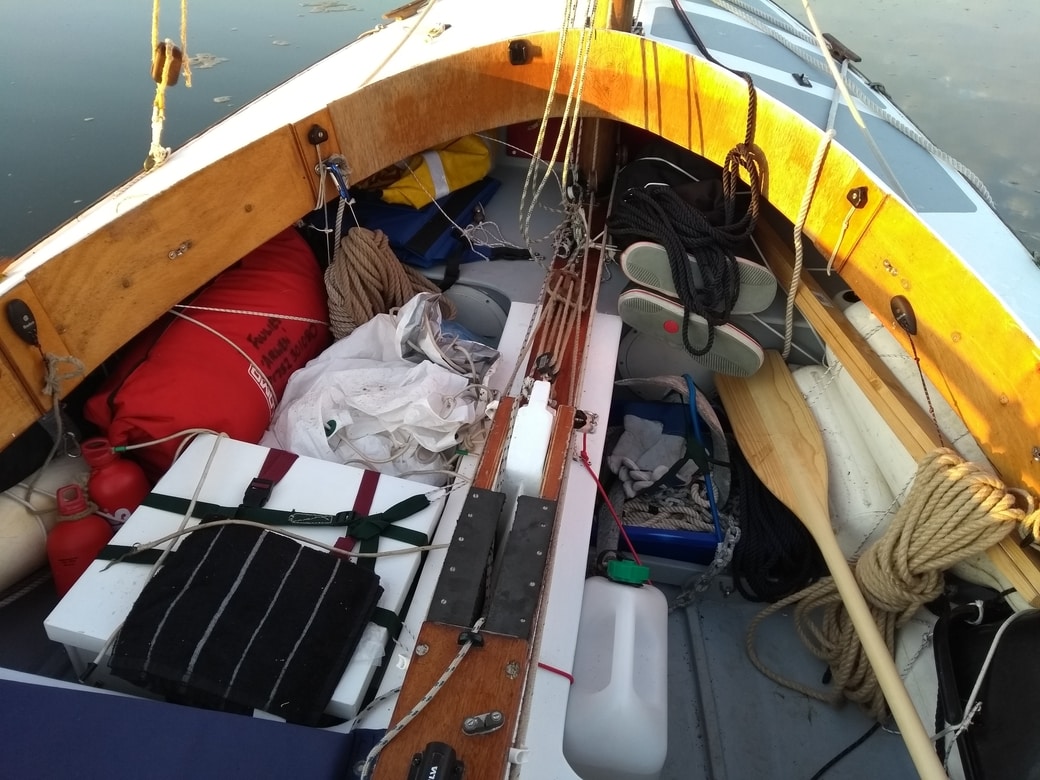 Is there such a thing as 'organised' chaos? Unbelievably, everything is in its correct place.
Is there such a thing as 'organised' chaos? Unbelievably, everything is in its correct place.
Feeling repentant, jib and mainsail are set for a more sedate beat up channel and I keep a watchful eye on centreboard and sail luff. I’m no longer too worried about grounding, after all it’s a muddy bottom and a rising spring tide. I’ll float off.
As the afternoon draws on, winds increase and gusts become fewer but much stronger, spilling off the surrounding southern hills. Is it time to reef? “The first time you think about reefing, that’s the time to do it”. I keep a wary eye out for the surface ripples that announce the arrival of stronger wind squalls. We push on!
On the northern hill behind, a glimpse of the four towered Ince Castle. Built in 1642 at the start of the English Civil War, Sir Henry Killigrew, a royalist MP, added the towers. One for each of his four wives, all of whom, so the story goes, remaining blissfully unaware of their competitors in the other towers. Four wives! He’d have a few tales to tell at a dinner party!
Farmers cut silage in the fine weather, their tractors and trailers criss-crossing the rolling Cornish hills. The throaty rumble of a hidden combine harvester carries on the breeze. I move to leeward; the shade of the mainsail is temporary relief from the scorching sun.
High-pitched outboard motors under strain herald the arrival of four black ribs, line astern, all big bow waves and long wakes of churning froth. The lead skipper, anticipating my need to tack north, alters course to port, a courteous attempt to give me room and minimise the wake impact on Arwen. Royal Marines, sit low, peering over the sides, heading for their secret beach overnight training bivouac. An arm emerges, a quick wave, from the bowels of the last passing boat. I wave back.
As Warren Point draws close, I anticipate a possible wind shadow effect and swiftly bear away onto a reach that will hopefully take me across to Redshanks Beach and straight up the Erth Hill channel. The tide has filled this sinuous channel but it will still be shallow in the mudflat margins around the various stripped channel marker poles.
Astern, paddle boarders emerge from Wacker Lake, past another abandoned quayside where barges once unloaded limestone and loaded up lime. There are remnants of a tiny military narrow-gauge railway, if you know where to look. Built in 1886, horse drawn trams hauled building stone from quayside over the hill to the stonemasons’ building Tregantle fort on the southern coast. Still owned by the navy, I’ve seen leisure boats moor off the quay overnight.
14.45pm I’d planned a short beaching on Redshank beach for a leg stretch across the saltmarsh, but there are three boats already there. Pity. A small stony beach with three conveniently spaced 2’ high scaffolding poles driven upright into the banks for mooring warps, many a time I’ve dropped a kedge anchor over the stern attached to my stretchy anchor buddy and then dried out on the beach top with a long saggy mooring warp running around one of the poles and back to Arwen’s bow cleat. On calm nights, with a small drift wood fire, pre- stripped long green sticks and a few marshmallows, it’s a delightful spot to stargaze and listen to the jumping bass and local tawny owls. Overnight, I’ve floated off the beach and been pulled back into deeper water ready for an early morning getaway.
Between Berry Down and steep sided Erth Hill, winds die. Wind shadow from the western high, steep, wooded shoreline? I didn’t anticipate that! Unshipping the oars, removing the steering compass and reaching for the boat cushion, I sit astride the centre case top and lean into the oars. Arwen is a wide beamed, stable, seaworthy boat, able to handle some serious seas, but being rowed long distances is not one of her design attributes. It’s hard work and knuckles get bruised as hands collide. Oars are at least 18” too short and rowlocks are set 13 inches aft of my seating position but my legs barely reach the aft cockpit floor. With the cushion I’m probably too high; without it, it’s a bottom numbing rowing position. Another winter project then, repositioning rowlock blocks and making longer length oars? Or perhaps, I could learn to yuloh scull over the transom. Is that even possible between a boomkin, mizzen mast, rudder stock and outboard bracket?
“No cheating, no outboard, no cheating – no outboard” My inner voiced mantra is interrupted by muffled laughter from below the treeline on the western bank. The marines have clearly arrived safely on the secret beach. It feels somewhat comedic that an elite stealth force is betrayed by laughter. The starboard oar crabs the bottom. I’ve meandered off course into the shallows. How do you row backwards and keep a straight track? Mental note, more practice doing rowing up the river Plym. Can I design a setup that allows me to row Arwen standing up and facing forward? And no, I don’t need a smart ass telling me that’s called ‘yuloh sculling’!
Trying to recall where the main channel meanders, I keep turning to check my position against the marker poles and so painfully crick my neck. To block out the pain I recall a history lesson from my son about the two storey, late thirteenth century chapel, with its faded medieval wall paintings. Hidden from gaze, somewhere on Erth Hill, the lower floor, with granite millstone, was a cider press while the upper floor was the chapel. The only known medieval document relating to it dates from 1413. Now a listed building, it is rather hard to find. Probably a good thing too.
I enter the expansive confluence where Sconner and Polbathic lakes greet the River Tiddy and Lynher, with relief and elation as the mizzen flutters. Wind! Yes, wind again. Oars are shipped, main sail re-hoisted and the faintest of breeze fills it. We move forward at 1.9 kts. I grab a handful of dangling main sheet and pull and ease it accordingly to gain a little more momentum. Now is not the time to keep hauling it through the blocks.
15.50pm and the mid-channel vertical scaffold pole that holds the pointy sign saying ‘To Treluggan Boatyard’ appears. I check its direction for nautical ruffians often swivel the pole so that the sign points the wrong way and you arrive at St German’s quayside on the river Tiddy instead. Not an unsavoury prospect by any means – a beautiful quayside with friendly sailing club, floating pontoon and a stunning Victorian railway viaduct as a backdrop. Half a mile to a lovely village pub, ask nicely and Quay Club members might let you overnight on the pontoon and possibly even open the sailing club bar for a jar or two. Pontoon occupied? Well, just north of the small slipway is a tiny muddy beach where a small dinghy can slip between running moorings for an overnight stop in front of the limekilns. Contact the Quay Sailing Club, out of courtesy though, to check that it is OK to use the pontoon or the beach before arriving.
 The 'changing position' sign post
The 'changing position' sign postOnlooking geese, motionless herons and animated ducks and crows watch the Mexican stand-off play out, from their grassy bank. With my one leg over the side, the goose stands erect, flaps his formidable wings and waddles closer down the mud shingle beach. Both legs over the side and with long neck outstretched ready to bite, the goose has a serious attack of the hissy fits. It is a 4’ gapped Paso Doble dance worthy of ‘Strictly Come Dancing’. There is little to do but admire the scenery and pray that the rising tide will float me free. I think those cackling crows on the washed-up tree branch are laughing at me!

Approaching geese beach!
Twenty minutes later, the rudder pops up, displaying new grey battle scars where white topcoat has been scrapped away, another winter project then! Goose has retreated to the beach head grassy knoll to be fussed over by his admiring flock. I’d marooned myself on the last remnants of an old quay wall, lowered in height by centuries of accumulated mud. A few rotting wooden posts had betrayed its position but I didn’t see them.
Paddling Arwen out into deeper water, I raise main sail once more and the gentle breeze sees us around the river bend, where I narrowly avoid the mid channel stranded tree trunk. Through looming railway viaduct arch spans, I spy the first of the moored live-aboard barges. “Treluggan, nearly there….no motor!” I whisper to myself but the inner pep talk isn’t having the desired effect. That gnawing sensation in the pit of my stomach is growing. “Please God, don’t let the wind drop; don’t let me ram the viaduct”.
The purple coloured brick parapets with their sprouting clumps of buddleia draw closer, white lime streaks adorning their curved arch ceilings. I check the yellow pilotage book. Of course, there is plenty of clearance, it’s obvious! But I need that reassurance. The middle span is marked as the fairway channel. I’m beginning to drift, the sails barely filling. I caress the paddle along the port thwart, feeling it’s comforting presence. “Faith me boy. Wind and tide will carry”.

Will the wind carry me through?
The main sags, the sprit boom sinks and swings slowly inward. Ten metres to go. Five metres. The trees on the western bank are causing a wind shadow. Didn’t anticipate that! I shiver involuntarily as the parapet shadows fall across Arwen. A small two coach train rumbles overhead.
And we are through. Barely, but we have emerged, unscathed. A saltmarsh appears on the western shore, ahead aluminium masts shimmer between the trees. We draw alongside what appears to be an old WW2 motor torpedo boat, its decks shrouded under white awnings and metal frames. Beyond its stern, the old wooden pontoon appears.
Whoosh!
At 57, I’m delighted by my lightning quick self-preservation reactions. Unnoticed by me the mainsail had slowly switched over to the port side as we shot the viaduct arch and now out of the wind shadow cast by hill and viaduct buttresses, it viciously shoots across the boat clearing my head by a mere inch or two. I head butt the cam cleat on the rear of the centreboard case. It hurts somewhat and whilst I am sure I haven’t fractured my skull, a deep impression of a cam cleat on my forehead is going to prove embarrassing when I arrive at the yard office in a few minutes time. I rub the affected area gingerly. Its tender! “Check the sails, check the course, check the sails, check the course – muppet!!”.
17.25pm, less than 50m to go, one vacant space on the pontoon behind an old large rubber rib that has seen better days. That green and white starboard marker pole is awfully close, showing how narrow the channel is here and despite the water reaching well beyond it, I vaguely remember seeing a very steep 2.5m high muddy bank beyond it on Google Earth. It’s high tide, I could continue upriver and quickly seek out the excavation site of the old ‘Lynher’ barge up at Poldrissick but will I be able to turn up there? [The story of how Charlie Force discovered and excavated the Barge is inspiring]. I have pushed my luck far enough today. This far upriver, tide is about to drain away very quickly. Time to stop.
Small fenders are deployed over the port side. “No paddle, no outboard”. I chant a little mantra to myself as we sidle down the moored boats. 15m, 10m. Barely a breeze, I’m ghosting. The rib’s stern falls halfway along Arwen’s beam and with a quick flick of tiller to starboard, we move forward inot the gap on the pontoon, the boomkin clearing a rib stern tube by inches. Barely a bump. Awesome!
Mainsail drops neatly between lazy jacks, a quick haul on the topping lift elevates boom and sail out of the way. Rudder released and a quick clamber over the centre case grabbing coiled stern and bow warps on the way. I step ashore and secure Arwen. Textbook arrival. From the Cattedown to Treluggan without the use of the outboard. “YES! RESULT. Get in there!” Of course, I didn’t embarrass myself by hollering this out loud but inside I was screaming it! For normal sailors this would have been a simple, unremarkable voyage. For me? It’s an achievement. No outboard. BOOM! [I discount using the outboard in and out of Sutton Pool – ever seen the chaos that ensues when small boats try to sail out of the marina and beat into the Cattedown? I rest my case!]

Arwen snug and set up for the night at Treluggan
Little niggle – what have I forgotten? Of course, high spring tide - how deep is the pontoon? How much slack do I need to put in the warps? I add four feet of slack and stern and bow spring lines to prevent me backing down onto the rib when the tide ebbs. Probably overkill but, I shudder at the thought of explaining how the boomkin pierced the rib chambers during the night. Ugh! Fenders are repositioned. Paranoid, I’m always paranoid.
Graham, the yard manager strolls down. “Saw you arrive on the camera. Welcome to Treluggan. Just came down to warn you – you’ll need around 4’ extra slack in your mooring warps on this tide. Don’t want to find yourself hanging at a crazy angle come low tide, do you?”

Treluggan, a proper traditional boatyard high up on the river Lynher
